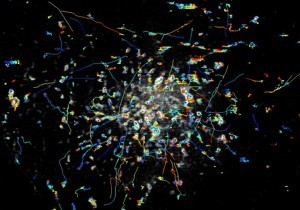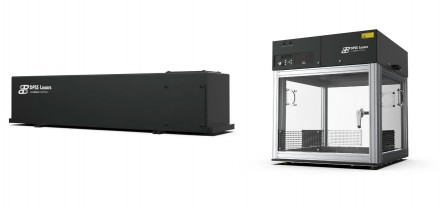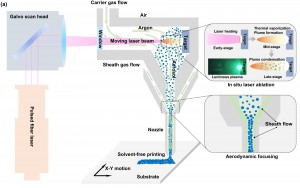
Researchers at the U.S. Department of Health & Human Services’ National Institute of Biomedical Imaging and Bioengineering (NIBIB) have merged two different microscope technologies — traditional total internal reflection fluorescence (TIRF) microscopy and instant structured illumination microscopy (iSIM) — to create sharper, faster images of rapidly moving processes inside living cells.
It is essentially an iSIM that has been adapted to function as TIRF microscope, describes Hari Shroff, PhD, the new device. He heads the Section on High Resolution Optical Imaging (HROI) at NIBIB. “We designed a simple ‘mask’ that blocks most of the illumination from an iSIM, which mimics a TIRF microscope.”
Two methods with their own drawbacks
TIRF microscopy has been around for more than 30 years. But the method has been limiting cell biologists because it produces blurry images of very small features within the cell. While previous attempts at applying super-resolution microscopy techniques to TIRF microscopes resulted in better resolution, the speed had to be sacrificed, rendering clear imaging of very fast moving objects impossible. So, many cellular processes that occurred on the very small scale could not be observed.
Developed by the Shroff lab in 2013, instant structured illumination microscopy (iSIM), on the other hand, can capture video at 100 frames per second but lacks the high contrast of TIRF
High spatial resolution and high speed in one device
The new instant TIRF-SIM microscope solves this problem by improving the spatial resolution of TIRF microscopy without compromising speed: The NIBIB team designed a simple “mask” that blocked most of the illumination from the iSIM — mimicking a TIRF microscope. “The instant TIRF-SIM is able to harness the strengths of both microscopes — the ability to image very fast, small things at high resolution — simultaneously with one device,” Shroff confirms.
In result, they were able to observe rapidly moving objects about 10 times faster than other microscopes at similar resolution.
The research advance could have an impact not only on the design of future microscopy technologies but it could also enable new discoveries in cell biology and other areas of nanoscience and even path the way to new cures: “Hopefully this new technology will allow researchers to gain a better understanding of how cellular structures work,” Shroff says. “Understanding cellular processes can give us a better understanding of a variety of biological problems, from cancer to immune disorders.”
The annular mask was key to success
The NIBIB scientists faced challenges in developing this new instant TIRF-SIM microscope, which they were eventually able to overcome: “Although I was fairly certain the idea would work, in our initial attempts to construct the setup, we failed due to poor alignment and improper positioning of the annular mask that was the key to the project,” Shroff reveals. By systematically correlating problems in imaging with problems in the alignment of the mask we were able to overcome these issues.
Having been able to eliminate the slowness factor in TIRF microscopy, the researcher is excited at the possibilities his team’s pioneering device may bring to the science community. “I am just happy that we have been able to sharpen the images produced by TIRF microscopes without introducing other drawbacks,” he says. “Given that TIRF is widely used, we hope others will find the system useful.”
The next step
In fact, Shroff and his colleagues are already reaching out to other researchers. “We are collaborating with several groups that are using the microscope on their own biology projects,” he says. “And now that the instrument is built, we want to see it used. We are also interested in working together with companies on commercializing the instrument.”
The work is detailed in the paper “Single-shot super-resolution total internal reflection fluorescence microscopy,” published in Nature Methods.
Written by Sandra Henderson, research editor Novus Light Technologies Today























 Back to Features
Back to Features



























